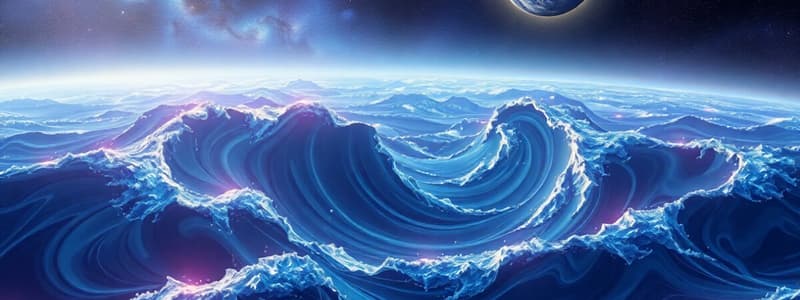Podcast
Questions and Answers
What defines the geoid in relation to the Earth's shape?
What defines the geoid in relation to the Earth's shape?
- A surface that represents the average sea level. (correct)
- A perfectly spherical shape.
- A flat plane extending infinitely.
- A point where gravity is weakest.
How does the Earth's rotation affect its shape?
How does the Earth's rotation affect its shape?
- It causes the radius at the equator to be larger than at the poles. (correct)
- It creates a perfect sphere.
- It has no effect on the Earth's shape.
- It causes the radius at the equator to be smaller than at the poles.
What influences the local variations in the strength of gravity?
What influences the local variations in the strength of gravity?
- Seasonal temperature changes.
- Regional mass distribution such as mountains and valleys. (correct)
- The time of day.
- The distance from the Earth’s core.
What happens to the ocean if tides and currents are removed?
What happens to the ocean if tides and currents are removed?
Which statement is true about the Earth's gravitational pull?
Which statement is true about the Earth's gravitational pull?
What defines the concept of zero elevation in geoid terms?
What defines the concept of zero elevation in geoid terms?
Why are precise instruments necessary in measuring variations in gravity?
Why are precise instruments necessary in measuring variations in gravity?
Which of the following is NOT a factor contributing to Earth’s shape?
Which of the following is NOT a factor contributing to Earth’s shape?
What causes the radius of the Earth to be larger at the equator compared to the poles?
What causes the radius of the Earth to be larger at the equator compared to the poles?
What effect does topography have on gravity in specific regions?
What effect does topography have on gravity in specific regions?
What is the geoid?
What is the geoid?
How do variations in gravity affect the Earth's liquid environment?
How do variations in gravity affect the Earth's liquid environment?
Why is the shape of the Earth not considered spherical?
Why is the shape of the Earth not considered spherical?
What is the primary reason for variations in the acceleration of gravity?
What is the primary reason for variations in the acceleration of gravity?
What would happen to the oceans if tides and currents were removed?
What would happen to the oceans if tides and currents were removed?
How does mass distribution on Earth affect gravitational strength?
How does mass distribution on Earth affect gravitational strength?
Flashcards are hidden until you start studying
Study Notes
Gravity and the Geoid
- Earth’s liquid environment responds to measurable variations influenced by mass distribution and gravitational pull.
- Tides and currents can distort ocean surface but, without these forces, the ocean would conform to a shape known as the geoid.
- The geoid surface represents zero elevation, defined by long-standing scientific conventions.
Earth's Shape and Gravity
- The Earth is not a perfect sphere; the equatorial radius exceeds the polar radius due to rotational effects.
- Variation in gravitational pull is influenced by local topography; mountains, possessing more mass, exert a stronger gravitational pull compared to valleys.
- Both large-scale (equatorial vs. polar radius) and small-scale (mountains vs. valleys) variations contribute to fluctuations in gravity's acceleration.
Measurement of Gravity Variations
- Precise instruments can measure gravity variations caused by changes in size, shape, and mass distribution of the Earth.
- Understanding these variations is crucial for disciplines such as geophysics and oceanography, as they impact not only gravity but also sea level and ocean currents.
Studying That Suits You
Use AI to generate personalized quizzes and flashcards to suit your learning preferences.




